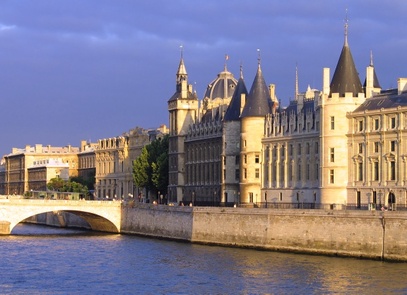
The monument
La Conciergerie and Sainte-Chapelle include the remains of the oldest Parisian royal palace ? the Palais de la Cité, which was converted into a prison in the15th Century.
This site, which was the residence of the Roman governors and later of the first Capetians, was chosen by Philippe le Bel in the early 14th Century as the place where he would build a palace to symbolise his power, described at the time as one of the most impressive palaces of the Middle Ages.
In the late 14th Century, the Capetian Kings abandoned the Palais de la Cité in favour of the palaces of the Louvre and Vincennes, leaving the building to be used by the Parliament of Paris and the kingdom’s central administration offices. « Le Concierge», nominated by the King (hence the name «La Conciergerie») to maintain order, to manage the police and to register prisoners, transformed a part of the building into a prison.
In the halls that were the setting for the Reign of Terror, Marie-Antoinette’s cell and a series of dungeons have been reconstituted. The chapel known as des Girondins, the expiatory chapel, created according to the wishes of Louis XVIII on the exact spot of Marie-Antoinette’s cell, the ladies’ court and the dressing room are also a moving memorial of the revolutionary era.
- The Monument
As the first royal palace in Paris, the palace de la Cité had its hour of glory under the Capetian monarchs, especially Philippe le Bel, who in the 14th century enlarged and transformed the building to make it the most sumptuous royal palace in medieval Europe and a symbol of his power. The hall of guards at the Conciergerie dates from this period, as do the huge soldiers’ hall and the kitchen built by Jean le Bon.
In the reign of Charles V, at the end of the 14th century, French kings began to prefer the palaces at the Louvre and Vincennes to the Palais de la Cité. They thus entrusted the old palace to the keeping of the Concierge, an individual who had extensive legal and police authority. The cellars of the building, which had for all practical purposes become a courthouse, were made into a prison. This function was confirmed over the centuries, and in 1793, the Conciergerie became the main prison of the revolutionary law courts
The rooms were rebuilt in the 18th century, and now house a historical presentation of the tragic hours of the Terror. Several cells have been reconstituted, including that of Marie-Antoinette.
The Visit of the Conciergerie
- The Salle des gens d’armes
Built in 14th Century in a gothic style, the salle des gens d’armes gives a reliable picture of the magnificence of the palace in Capetian times.
Appreciate the purity of the lines of vaulting, 8.5 metres high. An imposing size, the hall was built in two successive waves.
The hall was divided up in the 15th Century and used as premises for saddlers and shops. In the 19th Century, Peyre, and later Duc, restored the hall to its present volume
- The prison quarters
In this cell you will gain an idea of the life of prisoners under the Revolution.
Located on the first floor of the Conciergerie, detainees lived in extremely spartan conditions, sleeping on straw scattered on the floor.
The luckiest prisoners could pay high prices for a comfortable cell where meals could be delivered. But these conditions deteriorated, and under the Reign of Terror, all prisoners were returned to a single regime of detention
- The womens’ courtyard
This area has remained the same since the Revolution.
A small garden is located in its centre. The fountain in one corner was used by prisoners as a wash-house.
Men came to talk to the prisoners through the grate at the far end that you can just see.
The chambres à pistoles (the pistoles’ rooms) for the richest prisoners were on the first floor of the building. The straw-bed dormitory was on the ground floor.
- The kitchens
The kitchens were built around 1353 by Jean le Bon.
Square in shape, they cover two floors. The King took his meals on the upper floor, whilst the ground floor was assigned to the King’s household.
You will be surprised at the simplicity of this area, evidence of its purely domestic function.
Practical information
Conciergerie
2, boulevard du Palais
75001 Paris
Going there
Metro: lines 1, 4, 7, 11 and 14
Bus: 21, 24, 27, 38, 58, 81, 85 and Balabus
RER: lines B and C
Follow the Seine banks to Ile de la Cité
Localisation
Ile de la Cité (center of Paris)